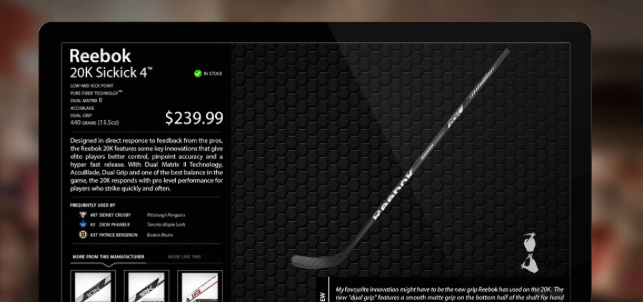How POET Displays aims to bring new meaning to retail experiences
by Patricia MacInnis — Mar 21 '14
by Patricia MacInnis — Mar 21 '14

Matt Neill’s experience as a barista at Starbucks and Tim Horton’s has served him well in understanding how retail markets can benefit from interactive media displays. Neill is a fourth-year student in University of Waterloo’s Rhetoric and Professional Writing program with a specialization in digital media studies.
He says shoppers’ current experience in retail environments is lackluster at best. He’s developed an interactive digital retail display called POET, or Point of Experience Terminal, which is designed to give users a rich, multimedia-based experience with the product or subject they’re showcasing. POET was originally profiled in CommerceLab in July of last year.
POET was installed in a pilot project at the City of Waterloo Museum for a recent exhibit celebrating 100 years of Seagram’s Whiskey. Neill spoke with CommerceLab about lessons learned in the pilot and why he thinks there’s a massive opportunity in retail for this type of technology.
Tell us how the POET displays were used to enhance the public’s experience at the Seagram’s Exhibit.
In October we did a project with City of Waterloo Museum at Conestoga Mall – 100 years of Seagram’s VO Whiskey. We put together an interactive installation where users come up and scan objects related to the distillation process – wheat in a jar, a particular bottle and that sort of thing – and when they scan that, the receive all kinds of information.
How did the project get started?
Last year in May we had an open house at the Felt Lab. We had a simulation of POET going on to demonstrate the possibilities of what we were trying to do. The City of waterloo representatives attended and we talked to them about the museum. This was the first really public installation and it was nice to have an actual physical installation that people in the public were interacting with. The city really let us test things out.
Describe the interface and display used at the Museum.
We were experimenting so we had to work with what the museum had on hand. Typically, the user interface is touch-screen, but the museum didn’t have the budget for that because they can get pretty expensive. To compensate, we integrated Leap Motion, a gesture based controller. At $80, it’s a relatively inexpensive solution, and allows users gestures to translate into actions on the screen. We integrated this hardware to simulate the touch screen experience.
Your original focus with POET was on the retail market. As your research continues, what are the biggest challenges you see in penetrating that market?
Our original focus was to go to retailers such as Sportcheck, for example, and install a a shoe wall – display for running shoes – with information served up on all the various types of running shoes. Sportcheck, in turn, would go to Nike, Adidas, Reebok and others to get information and feed it back to us. It seemed like a good plan, but who pays for this – the manufacturers or the retailer? The technology isn’t the question; it’s the politics around it.
We shifted our focus and instead will target the manufacturers directly. They already have a lot of content on their existing Web sites – videos, product images and useful information. Give it to us and we will make it look awesome.
Beyond retail and gallery types of spaces, have you had any interest from other industries?
We’ve been thinking of restaurants – the form factor doesn’t matter. You just need to scan something and learn about it, such as items on the menu. We’ve also been brainstorming about airports and how the technology could be used at gates.
We will be doing a lot more pilots in the near future to better understand how users use the technology. We will then take that data to potential clients and say this is the kind of thing we did. It raised sales by X and people used it X percentage of the time. And these are the benefits it can bring.
What inspired you to develop POET?
I worked in retail for seven years at Tim Horton’s and Starbucks. I want to change how people perceive retail environments. A lot of the time retail is a lackluster experience, hindered by not finding information or having to rely on someone. I want to change that and hand power back to the customer so they can make an informed decision.
What has been your greatest lesson as an entrepreneur?
It has become more apparent – as I dive deeper into this culture – that being an entrepreneur is half about what you’re selling and half about the relationships. A lot of companies have amazing developers, but if they don’t have people who can relate to customers and their business issues it’s going to fail.
How did being profiled on CommerceLab help POET’s entry to the market?
Especially since we are a student-run startup, exposure on the site was helpful to show people that we are taking things seriously. For example, many early-stage startups tell people that “we are having conversations with company X or Y,” when really they have somewhat exaggerated their relationship with that party. For us, it was useful to have a reputable source recognize the relationship the Felt lab/REAP has with industry experts, and consequently what POET has in terms of professional support. It allows us to tell people that what we’re doing isn’t arbitrary; we’re actually doing our homework and utilizing our resources.

Apr 17 '14

Apr 16 '14

Apr 15 '14

Apr 11 '14
Copyright © 2016 CommerceLab


